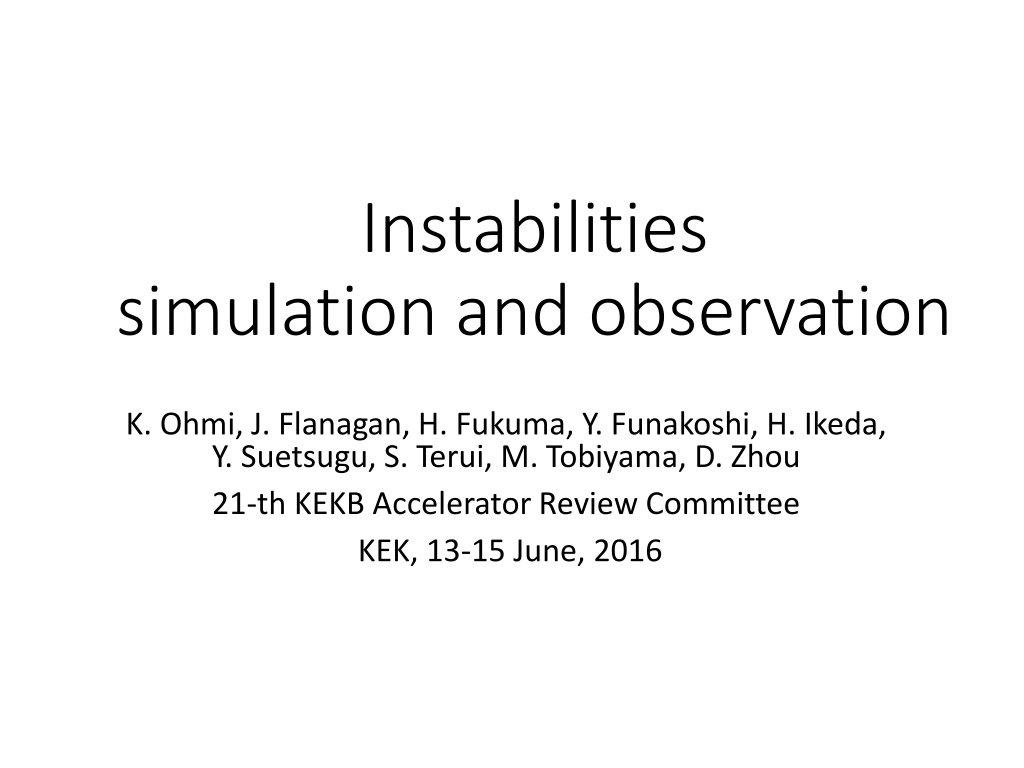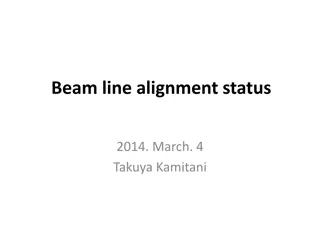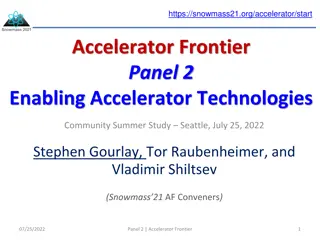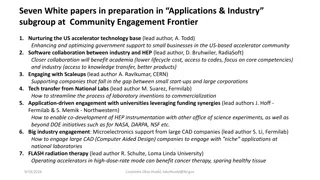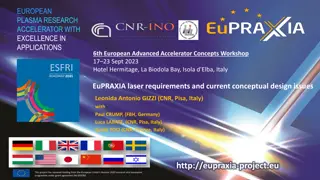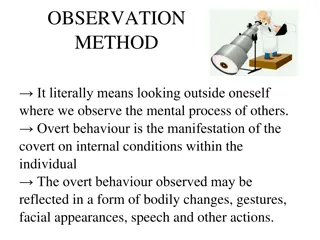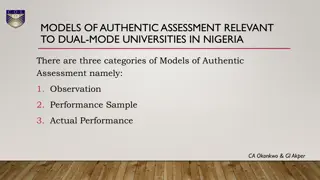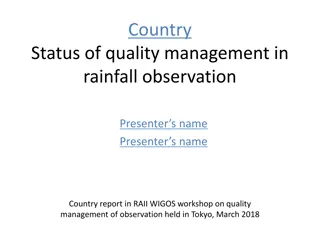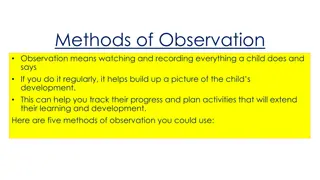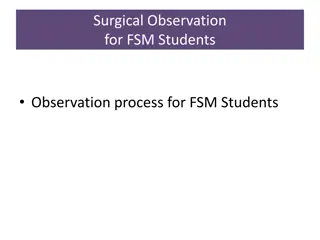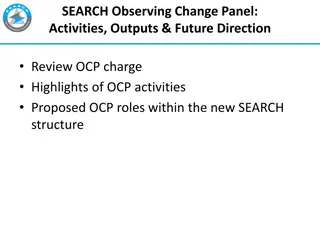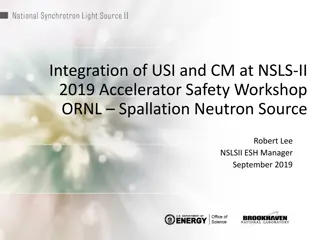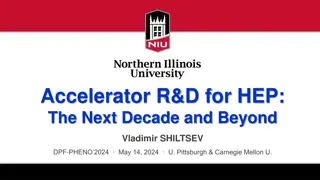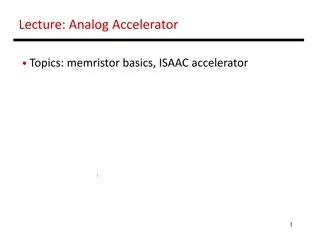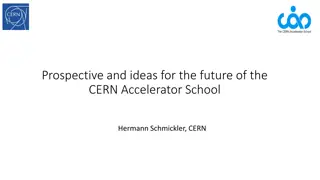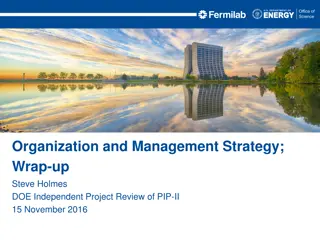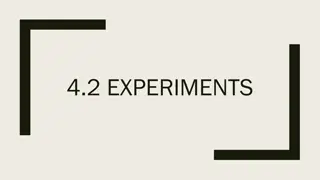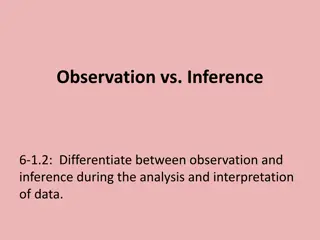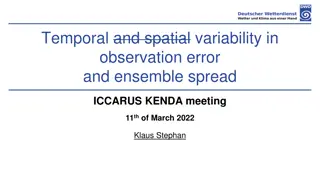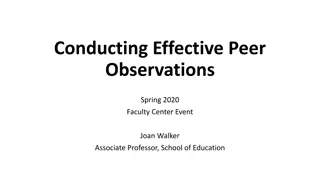Instabilities Simulation and Observation at KEKB Accelerator Review Committee
In the 21st KEKB Accelerator Review Committee, instabilities related to beam size blow-up, coupled bunch instability, and electron cloud effects were discussed based on simulations and observations. Various studies were presented, including threshold beam currents, electron density simulations, and measurements related to electron cloud effects. The research aimed to address challenges in beam stability and performance at the SuperKEKB design stage.
Download Presentation

Please find below an Image/Link to download the presentation.
The content on the website is provided AS IS for your information and personal use only. It may not be sold, licensed, or shared on other websites without obtaining consent from the author. Download presentation by click this link. If you encounter any issues during the download, it is possible that the publisher has removed the file from their server.
E N D
Presentation Transcript
Instabilities simulation and observation K. Ohmi, J. Flanagan, H. Fukuma, Y. Funakoshi, H. Ikeda, Y. Suetsugu, S. Terui, M. Tobiyama, D. Zhou 21-th KEKB Accelerator Review Committee KEK, 13-15 June, 2016
Contents Beam size blow-up due to Electron cloud Coupled bunch instability due to electron cloud Coupled bunch instability in HER Tune shift measurement and transverse impedance Bunch length measurement
Beam size blow-up in LER Beam-size blowup observed in KEKB has been seen in early stage of SuperKEKB commissioning 1. Threshold I~300mA in Apr 19 (Y. Funakoshi) 2. Electron cloud has been monitored at AL chamber w and w/o TiN coating (Y. Suetsugu). 3. Beast study threshold I~600mA, Nbunch=1576 in May 17 (Nakayama et al) 4. Systematic study in 1 June ( H. Fukuma et al.) 5. Permanent magnets are set at aluminum bellows.(Y. Suetsugu et al.) 6. Systematic studies in 8 July ( H. Fukuma et al.) June 1, 2016 4 train x150 bunches, Nbunch=600 Threshold beam current 160, 200, 260,500 mA for 2, 3, 4, 6 bucket spacing H. Fukuma et al.,
Instability simulation at SuperKEKB design stage Using code PEHTS e=4.2x1011at 4000-th turn Simulation, eth=3.8x1011m-3. Design target for vacuum system: e<1011m-3in average of whole ring
Simulation studies using beam study condition Threshold of the electron density x=2nm, y=15pm, z=6mm, s=0.019 Np=1.6x1010 Ith=160mA, 4ns spacing Np=2.7x1010 Ith=260mA, 8ns spacing Np=2.1x1010, y=100pm Np=2.4x1010, y=100pm Np=5.2x1010 Ith=500mA, 8ns spacing Np=2.1x1010 Ith=200mA, 6ns spacing
Simulated threshold electron density (condition before solenoid installation) Nb=600, x=2nm, y=15pm, z=6mm, s=0.019 e/2 (GHz) e z/c eth(Q=10) (1011m-3) eth(Q=6) (1011m-3) eth(Simu) (1011m-3) spacing Ip,th (mA) Np,th (1010) 2 (4ns) 160 1.6 61 7.7 1.91 2.45 3.4 3 (6ns) 200 2.1 71 8.9 1.65 2.45 3.4 4 (8ns) 260 2.7 80 10.1 1.47 2.45 3.8 6 (12ns) 500 5.2 111 14.0 1.47 2.45 5.0 3.06 500 2.0 37 5.5 2.89 2.90 4.4 Nb=1576, y=100pm 3.06 600 2.4 41 6.0 2.63 2.65 4.4 6
Electron cloud measurement Retarding bias, V=500V or 0V, select electrons with E>500eV or all, respectively. Electron E=500eV, v=1.3x107m/s. R/v=3.8ns, R=5cm, density can be estimated considering volume with energy gain 500eV from a bunch. 500eV may be critical for 2 (4ns) spacing. For V=0V, electron rate production including secondary is detected.
Measured electron current Y. Suetsugu Vr = -500 V Vr = -500 V Al Al wo coating Al w TiN coating Vr = 0 V Vr = 0 V Al wo coating Al w TiN coating For V=0V, 1 A, electron production rate is 0.3x109m-1/bunch 8
Electron density at the blow-up threshold Simulated electron density at the threshold current Measured threshold current and density Only Al part Simple formula Q=6
After installation of permanent solenoid at Al bellows Simulated electron density at the threshold current 2016/6/8 Ith=200 mA Ith=330 mA 4/150/2 4/150/3 4/150/4 Ith>600 mA Simple formula Q=6
Threshold of electron cloud density after solenoid attach e/2 (GHz) e z/c eth(Q=10) (1011m-3) eth(Q=6) (1011m-3) eth(Simu) (1011m-3) spacing Ip,th (mA) Np,th (1010) 2 (4ns) 200 2.1 71 8.9 1.65 2.45 3.4 3 (6ns) 330 3.5 91 11.5 2.45 4.8 4 (8ns) >600 >6.3 6 (12ns) 3.06 500 2.0 37 5.5 2.89 2.90 4.4 3.06 600 2.4 41 6.0 2.63 2.65 4.4
Simulated electron cloud build up in Drift Np=2.5x1010, I=240 mA for Nb=150x4=600 Np=4x1010, I=380 mA for Nb=600 e(r=0)~ ex1000 Np=9.4x1010, I=900 mA for Nb=600 Beam current: Slightly higher than measured threshold Ith=330 mA 2016/6/8 Ith=200 mA 4/150/3 4/150/4 4/150/2 Ith>600 mA Y1=Photon numberx0.1x0.01
CLOUDLAND, Fukuma E cloud buildup electron density near beam(m-3) max= Np=3.13x1010, Density R<4mm Y1=Photon numberx0.1x0.01 quantum eff. antechamber max= max= max= max= t(sec)
Coupled bunch instability caused by electron cloud Electron cloud motion reflects coupled bunch instability mode. Electrons in drift, short range wake ~10ns Electrons in solenoid, slow rotation around chamber surface. KEKB 400 f0 1000 f0
Unstable mode (before solenoid installation) M. Tobiyama Typical signal of coupled bunch instability caused by drift electrons 1000 f0 400 f0 Fast, strong 400 f0
Mode spectrum By 2 ver 300mA 400mA Solenoid origin Drift origin By 4 ver 350mA 600mA Solenoid origin Solenoid origin
Unstable mode (after solenoid installation) Typical mode caused by electrons in solenoid is seen. Mode seems to change to those of drift origin at high current. Solenoid modes 400 f0 540 f0 700 f0 Fast, strong
Coupled bunch instability in electron ring (HER) Ion? M. Tobiyama Fast, strong ???? = 5120 ??,?? Resistive wall 5120-1=5119 CO ?0
Impedance estimation- transverse Tune shift as function of bunch current 1 4?3/2 ? ???? ?0 ????? ??? ? ?? ?(??) ?? ?(??) ??= = 58.2 ?????(? ) = 33.3 HER LER ?????= 31 ? 53 ? ? /? ?????= 43 ? 145 ? ? /? LER x Collimator dependence HER y KEKB-LER: -0.0034mA-1, 81k /m coll. open 33-46 k /m T. Ieiri, EPAC00
Longitudinal impedance issue- Bunch length measurement L Measured by a Streak camera The behaviors are similar as KEKB for both of LER and HER. Bunch lengthening is stronger than that of simulation.
Summary Beam size blow-up has been observed since early stage of SuperKEKB commissioning. Electron density at Al bellows part (5% of circumf.) is high ( e>1012m-3). Simulations show the electrons can cause fast head-tail instability. Coupled bunch instability caused by electron cloud has also been observed as is predicted. Installation of Permanent solenoid reduced the blow up. It is possible to operate with 1A, 4 bucket spacing at present condition. Tune shift as function of bunch current was measured to estimate transverse impedance. It was 30-50k /m, similar as KEKB. Bunch length was measured by a streak camera. Bunch lengthening, which was similar as KEKB, was observed, 7-8 mm at the design current, while no bunch lengthening in prediction.
Rough estimation of Electron density Electron current, Ie=1 A. Acceptance of the electron detector, Smon=1 cm2. Number of electron absorbed (=produced) at chamber wall, d=10cm. 10 6 0.1? 1.6 10 19 10 4= 2 1016? 1? 1 ??= Electron stay time in the chamber, e=100ns. Electron density ??=2 1016 10 7 0.052? = 2.5 1011? 3
Emittance dependence Vertical emittance knob y=67m
Design current & spacing Np=9.4x1010, I=3600 mA
* PAC2005, p.1054 nb= A = = 0.0003x1/4 = 7.5E-5 Vb= [V] Nb= e+ Nb= nbfreve e = 1.602E-19 [C] frev= 1E5 [s-1] re= 2.818E-15 [m] me= 9.109E-31 [kg] c = 3.0E8 [ms-1] I I = [A] IobsnbVb D = 2.630E13 x I2 2/150/3 Vr= -30 V, I = 200 mA, Iobs= 1E-7 A ( ) D = 1.18E12 [e-m-3] nb= 600, Vb= 30 26
Simulated electron cloud build up in Bend Np=2.5x1010, I=240 mA for Nb=600 Np=4x1010, I=380 mA bucket bucket Np=9.4x1010, I=900 mA Ith=200 mA 4/150/3 Ith=330 mA 4/150/2 4/150/4 Ith>600 mA bucket Multipactoring arises Y2max>=1.5 at the threshold beam currents.
KEKB Solenoid-Off Experiment Simulation x 104 5 Horizontal 0.4 Horizontal 4 0.3 3 0.2 2 1 0.1 0 0 200 400 600 800 1000 1200 1400 0 0 200 400 600 Mode 800 1000 1200 1400 Mode x 103 Vertical 3 1.2 Vertical 2 0.8 1 0.4 0 0 0 200 400 600 800 1000 1200 1400 0 200 400 600 Mode 800 1000 1200 1400 Mode Su Su Win et al,(EC2002)
